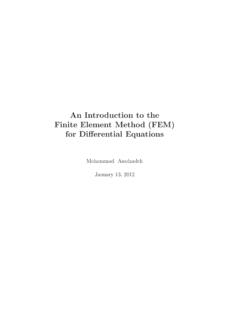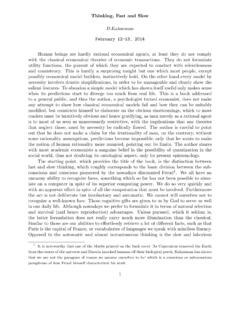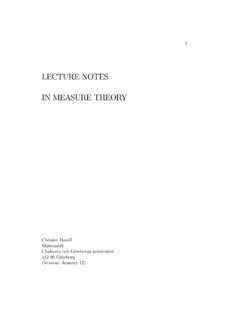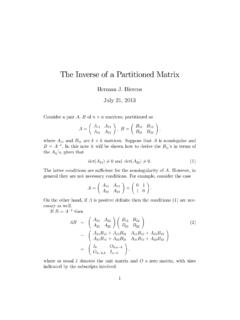Transcription of An Introduction to the Finite Element Method (FEM) for ...
1 An Introduction to theFinite Element Method (FEM)for Differential EquationsMohammad AsadzadehJanuary 20, 2010 Contents0 Preliminaries .. Trinities .. 61 Polynomial approximation in Overture .. Exercises .. 372 Polynomial Interpolation in Preliminaries .. Lagrange interpolation .. Numerical integration, Quadrature rule .. Gauss quadrature rule .. Exercises .. 623 Linear System of Direct methods .. Iterative Method .. Exercises .. 814 Two-points A Dirichlet problem .. Minimization problem .. A mixed Boundary Value Problem .. The Finite Element Method . (FEM) .. Error estimates in the energy norm .. Exercises .. 9734 CONTENTS5 Scalar Initial Value Fundamental solution and stability.
2 Galerkin Finite Element methods (FEM) for IVP .. An a posteriori error estimate for cG(1) .. A dG(0) a posteriori error estimate .. A priori error analysis .. The parabolic case (a(t) 0) .. Short summary of error estimates .. Exercises .. 1276 The heat equation in Stability estimates .. FEM for the heat equation .. Error analysis .. Exercises .. 1467 The wave equation in FEM for the wave equation .. Exercises .. 1548 Piecewise polynomials in several Introduction .. Piecewise linear approximation in 2 D .. Basis functions for the piecewise linears in 2 D .. Error estimates for piecewise linear interpolation .. TheL2projection .. Exercises.
3 1669 Riesz and Lax-Milgram Preliminaries .. Riesz and Lax-Milgram Theorems .. Exercises .. 17810 The Poisson Stability .. Error Estimates for FEM .. Exercises .. 191 CONTENTS511 The heat equation Stability .. Exercises .. 20012 The wave equation Exercises .. 20413 Convection - diffusion A convection-diffusion model problem .. Finite Element Method .. The Streamline - diffusion Method (SDM) .. Exercises .. 2146 CONTENTSC hapter 0 IntroductionThis note presents an Introduction to the Galerkin Finite Element Method (FEM), as a general tool for numerical solution of partial differential equa-tions (PDEs). Iteration procedures and interpolation techniques are alsoemployed to derive basica priorianda posteriorierror estimates, necessaryfor, solution properties, such as stability and convergence.
4 Galerkin smethod for solving a general differential equation (both PDEs and ODEs) isbased on seeking an approximate solution, which is1. easy to differentiate and integrate2. spanned by a set of nearly orthogonal basis functions in a Preliminaries Adifferential equationis a relation between an unknown functionuandits derivativesu(k), 1 k N, wherekandNare integers. If the functionu(x) depends on only one variable (x R), then the equationis called anordinary differential equation, (ODE). Theorderof the differential equation is determined by the order of thehighest derivative of the functionuthat appears in the equation. If the functionu(x,t) depends on more than one variable, and the derivativewith respect to more than one variable is present in the equation, then the78 CHAPTER 0.
5 Introduction differential equation is called apartial differential equation, (PDE), :ut(x,t) uxx(x,t) = 0 is a homogeneous PDE of second order,whereasuyy(x,y) +uxx(x,y) =f(x,y),is a non-homogeneous PDE of second order. A solution to a differential equation is a function; (x), u(t,x) oru(x,y). In general the solutionucannot be expressed in terms of elementary func-tions and numerical methods are the only way to solve the differential equa-tion by constructingapproximate solutions. Then the main question in hereis:how close is the approximate solution to the exact solution?and how andin which environment does one measure thiscloseness? In which extent theapproximate solution preserves the physical quality of theexact solution?
6 These are some of the questions that we want to deal with in this notes. The linear differential equation of ordernin time has the general form:L(t,D)u=u(n)(t) +an 1(t)u(n 1)(t) +..+a1(t)u (t) +a0(t)u(t) =b(t),whereD=d/dtdenotes the ordinary time derivative, andDk=dkdtk,1 k n. The correspondinglinear differential operatoris denoted byL(t,D) =dndtn+an 1(t)dn 1dtn 1+..+a1(t)ddt+a0(t). TrinitiesTo continue we introduce the so calledtrinitiesclassifying the main ingredi-ents involved in the process of modeling and solving problems in differentialequations, see Karl E .Gustafson [14] for usual three operators involved in differential equations areLaplace operator n= 2 x21+ 2 x22+..+ 2 x2n,( )Diffusion operatorddt n,( )D Alembert operator =d2dt2 n,( ) TRINITIES9where we have the space variablex:= (x1,x2,x3.)
7 Xn) Rn, the timevariablet R+and 2/ x2idenotes the second partial derivative with respecttoxi. We also recall a first order operator: the gradient operator nwhichis a vector valued operator and is defined as follows: n= x1, x2,.., xn .Classifying the general second order PDEs in two dimensionsThe usual three classes of second order partial differentialequations areel-liptic, order PDEs with constant coefficients in 2-D:Auxx(x,y)+2 Buxy(x,y)+Cuyy(x,y)+Dux(x,y)+Euy(x,y)+Fu (x,y)+G= we introduce thediscriminantd=AC B2: a quantity that specifiesthe role of the coefficients in determining the equation Type of equationSolution behaviord=AC B2>0 Ellipticstationary energy-minimizingd=AC B2= 0 Parabolicsmoothing and spreading flowd=AC B2<0 Hyperbolica disturbance-preserving waveExample are the class of the most common equations.
8 EllipticParabolicHyperbolicPotential equationHeat equationWave Equationd2udx2+d2udy2= 0dudt u= 0d2udt2 u= 0uxx(x,y) +uyy(x,y) = 0ut(t,x) uxx(t,x) = 0utt(t,x) uxx(t,x) = 0A=C= 1,B= 0A=B= 0,C= 1A= 1,B= 0,C= 1d=AC B2= 1>0d=AC B2= 0d=AC B2= 1< 0. INTRODUCTIONS econd order differential equations with variable coefficients in 2-DIn the variable coefficients case, one can only have a local the Tricomi operator of gas dynamics:Lu(x,y) =yuxx+ the coefficientyis not a constant and we haveA=y, B= 0,andC= 1. Henced=AC B2=yand consequently, the domain ofellipticity isy >0, and so on (see the Fig. below)ellipticparabolicxyhyperbolicFigur e 1:Tricomi: an example of a variable coefficient classification. Summing up and generalizing tonspace variables we haveMathematical SurnamePhysicalClassificationQuantityNam edType nLaplacianPotential operator Ellipticddt n 1 HeatDiffusion operator Parabolic =d2dt2 n 1d Alembertian Wave TRINITIES11 The usual three types problems in differential equations1.
9 Initial value problems (IVP)The simplest differential equation isu (x) =f(x) fora < x b, but also(u(x) +c) =f(x) for any constantc. To determine a unique solution aspecification of the initial valueu(a) =u0is generally required. For exampleforf(x) = 2x,0< x 1, we haveu (x) = 2xand the general solution isu(x) =x2+c. With aninitial valueofu(0) = 0 we getu(0) = 02+c=c= the unique solution to this initial value problem isu(x) =x2. Likewisefor a time dependent differential equation of thesecond order(two timederivatives) the initial values fort= 0, ,u(x,0) andut(x,0) are generallyrequired. For a PDE such as the heat equation the initial value can be afunctionof the space wave equation, on real line, associated with the given initialdata: utt uxx= 0, < x < t >0,u(x,0) =f(x), ut(x,0) =g(x), < x < , t= Boundary value problems (BVP)a.
10 Consider the boundary value problems inR:Example heat equation: [a(x)u (x)] =f(x),for0< x < define a solutionu(x)uniquely, the differential equation is comple-mented by boundary conditions imposed at the boundariesx= 0andx= 1: for exampleu(0) =u0andu(1) =u1, whereu0andu1are givenreal Boundary value problems (BVP) inRn:Example Laplace equation inRn,x= (x1,x2,..,xn): nu= 2u x21+ 2u x22+..+ 2u x2n= 0,x Rn,u(x,t) =f(x),x (boundary of ).12 CHAPTER 0. INTRODUCTIONR emark general, in order to obtain a unique solution for a (partial)differential equation, one should supply as many data as the sum of highestorder (partial) derivatives involved in the equation. Thusin example 1, todetermine a unique solution for the potential equationuxx+uyywe need togive 2 boundary conditions in thex-direction and another 2 in they-direction,whereas to determine a unique solution for the wave equationutt uxx= 0,it is necessary to supply 2 initial and 2 boundary Eigenvalue problems (EVP)LetAbe a given matrix.



















